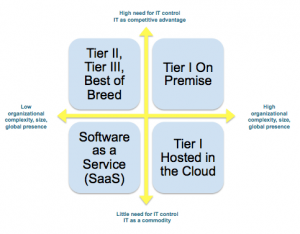ERP
ERP Implementations: Cloud vs. On-Premise Deployment Strategies

One of the key benefits of software as a service (SaaS) and cloud ERP systems is that the technological deployment of the software can be easier than traditional, on-premise implementations. Easier access to the software, less need for an expensive IT infrastructure, and easier maintenance and upgrades are common reasons cited by executives and CIOs that choose cloud-based solutions for their organizations’ ERP implementations. This is a key reason why Salesforce, Workday, Plex Systems, and other SaaS ERP systems have grown so aggressively in recent quarters. In fact, our 2012 ERP Report reveals that the cloud and SaaS market has grown from 6-percent of all ERP implementations in 2010 to 16-percent in 2011.
However, as with any type of ERP implementation, each potential option comes with its own trade-offs. While traditional, on-premise ERP implementations are notorious for being costly and risky in a number of ways, SaaS and cloud ERP systems lack some of the flexibility, stability and control desired by many executives. So while it may be tempting to give in to cloud marketing hype – which there is plenty of in today’s ERP market – it is important to carefully assess the pros and cons of SaaS and cloud-based solutions before making a final decision.
Below are four variables to consider when evaluating cloud versus on-premise ERP implementation strategies:
Flexibility and control.
On the one hand, SaaS and cloud ERP software is more flexible in that it can be easily deployed from a purely technological perspective. In other words, there are no CDs to install, no servers to purchase, and no risky and costly customizations to make to the software. On the other hand, because SaaS solutions are multi-tenant systems shared across multiple companies, there is inherently less flexibility in changing the software to accommodate the business process needs of the organization (see diagram below). These tradeoffs on both sides of the spectrum have benefits, costs, and risks that are likely to vary from company to company.

Total cost of ownership.
While initial technological startup costs may seem lower for SaaS and cloud solutions, this is not necessarily true in the long-term. For every server an organization doesn’t have to buy, it has a certain amount of ongoing annual subscription costs that go into perpetuity for as long as it uses its SaaS solution. Much like leasing versus buying a car, SaaS solutions can entail higher annual costs and hidden fees, while purchased on-premise software has relatively lower costs after the initial investment. In addition, basic implementation needs – such as defining business processes and training employees – are fixed project investments that are incurred for both cloud and on-premise ERP deployments. We find that with most of our clients, the breakeven for SaaS versus on-premise is somewhere between five and seven years, meaning that on-premise ERP often becomes more economical five to seven years after implementation.
CFOs and balance sheets.
In many cases, the SaaS versus on-premise ERP decision boils down to the balance sheet and the office of the CFO. Most companies have varying degrees of comfort with increasing their capital investments, which can be depreciated over time, versus their ongoing annual expenses. CFOs that are more concerned with containing annual expenses are going to favor on-premise ERP systems, while those that want to limit capital expenditures and optimize their return on assets will lean toward SaaS. We’ve seen several instances where our analysis will point one direction from a functional and strategic perspective, only to be overturned by the CFO with specific financial objectives.
Don’t forget hybrid options.
“Cloud” and “SaaS” are often used interchangeably and many executives believe that there is a black and white decision between one or the other, but they often fail to realize that hybrid options are additional possibilities. Companies may want the flexibility and control of on-premise solutions, but they may also want to minimize their capital investment in their IT infrastructure. Many of these organizations are going down the path of purchasing traditional, on-premise software, but having it hosted in the cloud outside their four walls. These hybrid options are the fastest growing segment of our larger, more complex, multi-national clients, and a key driver of recent growth in the cloud segment.
At the end of the day, there is no one size fits all strategy for our clients and other organizations. Each strategy has pros, cons, trade-offs and risks, which all need to be examined in the context of your unique business needs and priorities.
Want more on ERP Software? Discover and learn more about ERP software by exploring blog posts, whitepapers and more on our ERP resource page. For comparisons of the best ERP software, download Business-Software.com’s Top 20 ERP Software report.
[This post originally appeared on Panorama Consulting’s 360 ERP blog and is republished with permission.]






